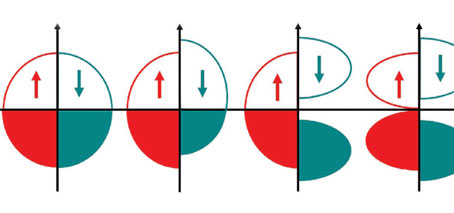Media release
From: ARC Centre of Excellence in Future Low-Energy Electronics Technologies (FLEET)A collaboration across three FLEET nodes has reviewed the fundamental theories underpinning the quantum anomalous Hall effect (QAHE).
QAHE is one of the most fascinating and important recent discoveries in condensed-matter physics.
It is key to the function of emerging ‘quantum’ materials, which offer potential for ultra-low energy electronics.
QAHE causes the flow of zero-resistance electrical current along the edges of a material.
QAHE IN TOPOLOGICAL MATERIALS: KEY TO LOW-ENERGY ELECTRONICS
Topological insulators, recognised by the Nobel Prize in Physics in 2016, are based on a quantum effect known as the quantum anomalous Hall effect (QAHE).
“Topological insulators conduct electricity only along their edges, where one-way ‘edge paths’ conducts electrons without the scattering that causes dissipation and heat in conventional materials,” explains lead author Muhammad Nadeem.
QAHE was first proposed by 2016 Nobel-recipient Prof Duncan Haldane (Manchester) in the 1980s, but it subsequently proved challenging to realize QAHE in real materials. Magnetic-doped topological insulators and spin-gapless semiconductors are the two best candidates for QAHE.
It’s an area of great interest for technologists,” explains Xiaolin Wang. “They are interested in using this significant reduction in resistance to significantly reduce the power consumption in electronic devices.”
“We hope this study will shed light on the fundamental theoretical perspectives of quantum anomalous Hall materials,” says co-author Prof Michael Fuhrer (Monash University), who is Director of FLEET.
THE STUDY
Quantum Anomalous Hall Effect in Magnetic Doped Topological Insulators and Ferromagnetic Spin-Gapless Semiconductors – A Perspective Review was published in the journal Small in September 2020 (DOI 10.1002/smll.201904322).
The study was supported by the Australian Research Council (Centres of Excellence and Future Fellowship projects).
TOPOLOGICAL MATERIALS AT FLEET
Topological materials and other novel quantum materials are studied at FLEET, an Australian Research Council Centre of Excellence, within the Centre’s Research theme 1 and Enabling technology A.
The Centre for Future Low-Energy Electronics Technologies (FLEET) is a collaboration of over a hundred researchers, seeking to develop ultra-low energy electronics to face the challenge of energy use in computation, which already consumes 8% of global electricity, and is doubling each decade.
FLEET will develop 2D topological insulators with large bandgaps in their interior, sufficient for conduction of edge modes at room temperature without dissipation. Ultra-low power topological transistors will be developed, in which the dissipationless channel along the boundary between a topological and conventional insulator is switched on and off by the application of a gate voltage.




